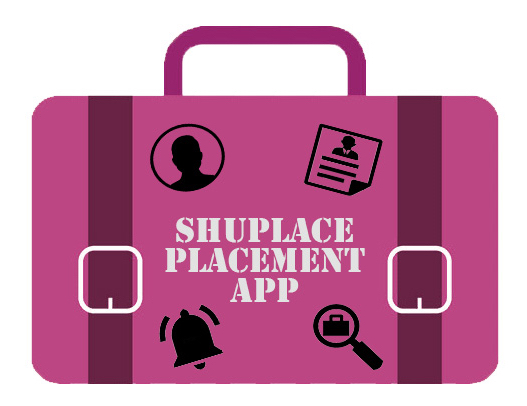
(Logo created by me using Photoshop)
Shuplace Placement app has been created to enhance the accessibility and convenience for the students who are looking for job opportunities as students can search for jobs having all the tools in one place. Students within the STEM department from Sheffield Hallam Univerisity are the main target audience. The app would allow employers to post jobs directly to the app, and to be regulated by the university’s placement team. The final goal of the app is that it could be used by media students at different universities, and our main target is the placement teams that can specialise the app for different courses.
For market and product research, we found that student job applications were mainly on the internet and not apps that we thought were not useful as students were the main users of mobile apps for convenience., “For university students, the availability, convenience and low cost of mobile applications (apps) present new opportunities to fit learning into their busy lives outside class.” (Steel, C. 2012, pp.1). Therefore, our app and idea were inspired by other social media outlets that are work focused like LinkedIn.

(Moore, 2018)
According to the Office for National Statistics 2019, the country’s unemployment rate currently stands at a relatively low 3.8% and the graduate labour market remains robust and by some measures is as strong as it has been for some time. Therefore, the competition for graduate jobs is fierce and companies needed a way to filter out applicants, in came the computer algorithms that will look at your CV to filter out applicants. LinkedIn can be a valuable tool in your job search as businesses, recruiters and head-hunters will use LinkedIn to search for candidates for particular jobs and then approach them directly (The Guardian, 2017).

(Pinterest, 2017)
There is still discrimination in jobs, even when computers do important filtering work. While, by definition, an algorithm is devoid of thought, stereotyping, and bias, the fact remains that its design is created by human hands. In 2014, Amazon started looking to see if AI could help it sort through people applying to work at the company. By the following year, it had become apparent that the algorithm only accepted resumes submitted by men. This surprising finding was later explained by the fact that the method looked at applications from the previous 10 years, the era during which men dominated the technology industry, so the mathematical calculations concluded that men were more suitable for the technology industry (Fortune, 2018). Therefore, the creation of algorithms to select the “most suitable” candidate does not always mean choosing the candidate who is the best.
(Financial Times, 2019)
The mistake had nothing to do with any bad intentions on the part of the person who designed the algorithm, but it demonstrated the complexity of creating a perfect algorithm (and blindly trusting it). In 2017, Amazon abandoned the initiative and returned to conventional recruiting practices, delaying the use of predictive analytics for recruitment at a later time (The Guardian, 2018). Yet another study by the National Bureau of Economic Research (NBER) proved market disposition towards white names (such as ‘Emily’ or ‘Greg’) that got more callbacks for interviews than black names (such as ‘Lakisha’ and ‘Jamal’). Thus, algorithms have become a part of the real world with them in everything, but when you apply for a job, they are considered to be the new norm. They experimentally manipulated perception of race via the name on the resume and we have become accepting of the technology in the future. However, this is a broader issue which affects more than just our searched job and future employment.
For general, an HR department inputs the current employee details to configure an algorithm for recruiting, so that the algorithm can create ideal applicant profiles that are compatible with the principles and spirit of the organisation. This is used hoping to reduce the errors in hiring someone whose profile does not correspond to the ethos of the company. As a result, the algorithm will favour applicants closer to what it sees as the best profiles, thus considerably reduce the diversity of applicants. Naturally, this will have an impact on the variety of these applicants, in terms of experience, skills, and personality (Gabriel, 2019). 
Today, recruiters at large companies such as Target, Hilton, Cisco, PepsiCo and Amazon are using predictive recruiting software to both reduce the time and expense of each new hire-and hypothetically increase the quality and tenure. Knowing at which points in the hiring process algorithms come into play will help identify the source of bias (Bogen & Rieke, 2020). Therefore, Shuplace Placement app has been created to fill the media world with the need for placement-oriented work. I agree that a discussion now needs to be held about what new theory should be developed to address the algorithms of repercussions. This is because of Williams, C.L (2013) argued that “new concepts are needed to understand workplace gender inequality in the 21st century.”

(Computer Science Basics: Algorithms, 2018)
In addition, one way to avoid algorithmic bias is to stop making hard-screening, algorithm-based decisions. Encourage a human examination to ask experienced individuals who have been through bias training to supervise selection and assessment. Let decisions be driven by a person informed by algorithms, rather than a single algorithm. Can recruiting completely eliminate bias and prejudice? The response is “probably not” for both algorithmic and human approaches. However, as big data, machine-learning algorithms, and human analytics assume a greater and more influential role in recruitment, HR practitioners must consider the consequences of these technologies and ensure that they always represent the best human intentions (Mann & O’Neil, 2016).

(TechBusket, 2017)
In conclusion, digital is remaking the workforce, and in companies with enlightened and forward-thinking management, it presents new opportunities for career growth (Forbes, 2016). Therefore, more research needs to be done within media technology as the way technology has changed the last decade and the world of job searches is a major reason. Fresh graduates can have a harder time finding a job than they expect in this job climate and we know it but we know that a competitive job market shouldn’t stop them from reaching for their goals and we are going to work on finding a solution for the future.
Bibliography
- Amazon ditched AI recruiting tool that favoured men for technical jobs. (2018). Retrieved 15 January 2020, from https://www.theguardian.com/technology/2018/oct/10/amazon-hiring-ai-gender-bias-recruiting-engine
- Amazon Killed an AI Recruitment System Because It Couldn’t Stop the Tool from Discriminating Against Women. (2018). Retrieved 15 January 2020, from https://fortune.com/2018/10/10/amazon-ai-recruitment-bias-women-sexist/
- Bogen, M., & Rieke, A. (2020). An Examination of Hiring Algorithms, Equity, and Bias. Retrieved 15 January 2020, from https://www.upturn.org/static/reports/2018/hiring-algorithms/files/Upturn%20–%20Help%20Wanted%20-%20An%20Exploration%20of%20Hiring%20Algorithms,%20Equity%20and%20Bias.pdf
- Computer Science Basics: Algorithms. (2018). [Image]. Retrieved from https://www.youtube.com/watch?v=kM9ASKAni_s
- Employers’ Replies to Racial Names. (2020). Retrieved 15 January 2020, from https://www.nber.org/digest/sep03/w9873.html
- Financial Times (2019). How artificial intelligence helps companies recruit talented staff. Retrieved 15 January 2020, from https://www.ft.com/content/2731709c-3043-11e9-8744-e7016697f225
- Forbes (2016). 5 Ways Digital Technology Is Changing Your Job. (2016). Retrieved 16 January 2020, from https://www.forbes.com/sites/joemckendrick/2016/12/29/5-ways-digital-technology-is-changing-your-job/#1bef64d064bd
- Guardian Jobs (2017). How to use social media in your job search. Retrieved 14 January 2020, from https://jobs.theguardian.com/article/how-to-use-social-media-in-your-job-search/
- Mann, G., & O’Neil, C. (2016). Hiring Algorithms Are Not Neutral. Retrieved 15 January 2020, from https://hbr.org/2016/12/hiring-algorithms-are-not-neutral
- Moore, T. (2018). Can You Game the Recruiting Algorithm With This Résumé Hack?. Retrieved 15 January 2020, from https://melmagazine.com/en-us/story/can-you-game-the-recruiting-algorithm-with-this-resume-hack
- Nine Reasons Your Resume Gets Rejected. (2017). [Image]. Retrieved from https://www.pinterest.com/pin/701365341938848701/
- Steel, C. (2012). Fitting learning into life: Language students’ perspectives on the benefits of using mobile apps. In ascilite (pp.1).
- TechBustket (2017). [Image]. Ways In Which Technology Has Changed The World Of Marketing. Retrieved from https://www.techbusket.com/tech-news/ways-technology-changed-world-marketing/
- Unemployment – Office for National Statistics. (2019). Retrieved 15 January 2020, from https://www.ons.gov.uk/employmentandlabourmarket/peoplenotinwork/unemployment
- What If Your Recruiter Were an Algorithm?. (2019). Retrieved 15 January 2020, from https://www.welcometothejungle.com/en/articles/what-if-your-recruiter-were-an-algorithm
- Williams, C.L. (2013). The Glass Escalator, Revisited: Gender Inequality in Neoliberal Times, SWS Feminist Lecturer. Retrieved 10 January 2020, from https://www.researchgate.net/publication/269862695_The_Glass_Escalator_Revisited_Gender_Inequality_in_Neoliberal_Times_SWS_Feminist_Lecturer





